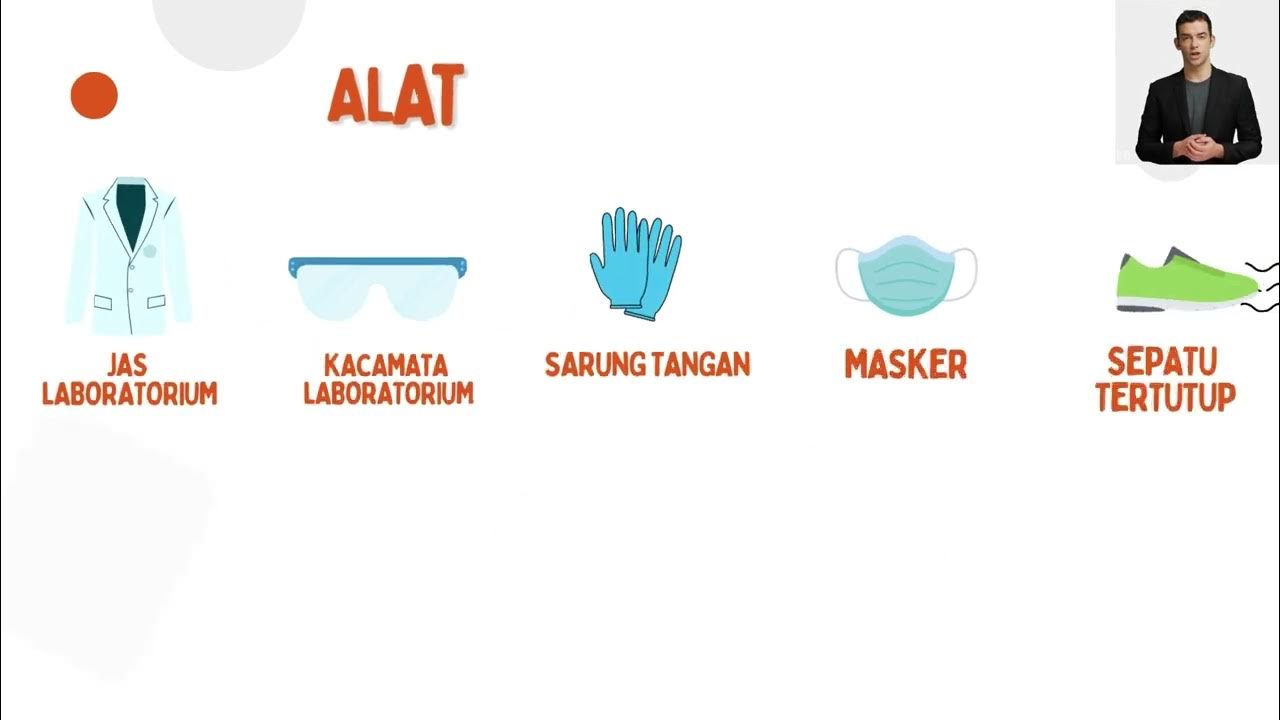Lab Safety
Summary
TLDRThe video script outlines essential lab safety protocols to ensure a safe and effective learning environment during science experiments. It emphasizes the importance of adult supervision, protective gear like goggles and gloves, and following proper instructions. The script also covers how to handle accidents, such as dealing with flames, cuts, or chemical exposure, and the correct disposal of materials after experiments. By adhering to these safety guidelines, students can safely explore science while preventing injuries and accidents.
Takeaways
- 🧑🔬 Always follow lab safety rules to prevent injuries during experiments.
- 👩🏫 All experiments must be supervised or approved by an adult.
- 📖 Read all experiment directions carefully before starting to ensure proper preparation.
- 🧹 Maintain a clean workspace for better organization and observation of experiment results.
- 👓 Wear goggles, lab aprons, and gloves as instructed to protect against harmful substances.
- ⚠️ Only perform authorized experiments and avoid eating or drinking during lab activities.
- 👃 For odor-related tasks, waft the air toward your nose instead of inhaling directly.
- 🔥 Take extra care around open flames and know how to use a fire extinguisher if necessary.
- 🚑 In case of cuts, flush the wound with water and follow appropriate first-aid measures.
- 🧼 Clean all lab tools, dispose of chemicals safely, and wash your hands after completing the lab.
Q & A
Why is it important to follow safety rules in a lab?
-Following safety rules in a lab is important to prevent injuries and ensure that experiments are conducted safely, minimizing risks.
What should be done before starting a lab experiment?
-Before starting a lab experiment, you should read over all directions carefully to understand the materials needed and the steps involved.
Why is it necessary to work in a clean space during an experiment?
-A clean workspace helps you stay organized, ensures proper observation of the experiment, and reduces the chance of contamination or accidents.
What protective gear is commonly required in a lab setting?
-Common protective gear in labs includes goggles to protect the eyes, lab aprons to protect clothing, and gloves to protect the skin.
What should you do if you need to observe the odor of a substance during an experiment?
-You should not inhale directly; instead, gently wave air from the container towards your nose with your hand to get an idea of the odor.
What precautions should be taken when working with open flames in the lab?
-Keep all flammable materials away from the flame, know the location of a fire extinguisher, and be familiar with how to operate it in case of fire.
What steps should be followed if you get a cut during a lab experiment?
-Flush the wound with running water, then take appropriate first-aid measures to clean and protect the area.
How should broken glass be cleaned up in a lab?
-Use a dustpan and broom to clean up broken glass, and dispose of it in the garbage to avoid injury.
What is the proper way to flush your eyes if they come into contact with a chemical irritant?
-Flush each eye gently with water, using either a shower or a small cup of clean water, keeping the eye open. If wearing contact lenses, remove them before flushing.
What should be done after completing a lab experiment?
-Clean your workspace, dispose of chemicals properly as instructed, wash any reusable tools with soapy water, and wash your hands to remove any remaining materials.
Outlines

Esta sección está disponible solo para usuarios con suscripción. Por favor, mejora tu plan para acceder a esta parte.
Mejorar ahoraMindmap

Esta sección está disponible solo para usuarios con suscripción. Por favor, mejora tu plan para acceder a esta parte.
Mejorar ahoraKeywords

Esta sección está disponible solo para usuarios con suscripción. Por favor, mejora tu plan para acceder a esta parte.
Mejorar ahoraHighlights

Esta sección está disponible solo para usuarios con suscripción. Por favor, mejora tu plan para acceder a esta parte.
Mejorar ahoraTranscripts

Esta sección está disponible solo para usuarios con suscripción. Por favor, mejora tu plan para acceder a esta parte.
Mejorar ahoraVer Más Videos Relacionados

Bab 1 Hakikat Ilmu Sains dan Metode Ilmiah #2 (Laboratorium IPA) | IPA SMP 7 | Sekolah Penggerak

Keselamatan Kerja di Laboratorium IPA Mata Kuliah Pendalaman Materi IPA

Safety Mindset - Video 1

Lab Safety Video

Aula Prática: EPI's e EPC's no Laboratório de Química

Praktikum Kimia Dasar Modul 1. Pengenalan Alat Laboratorium
5.0 / 5 (0 votes)
